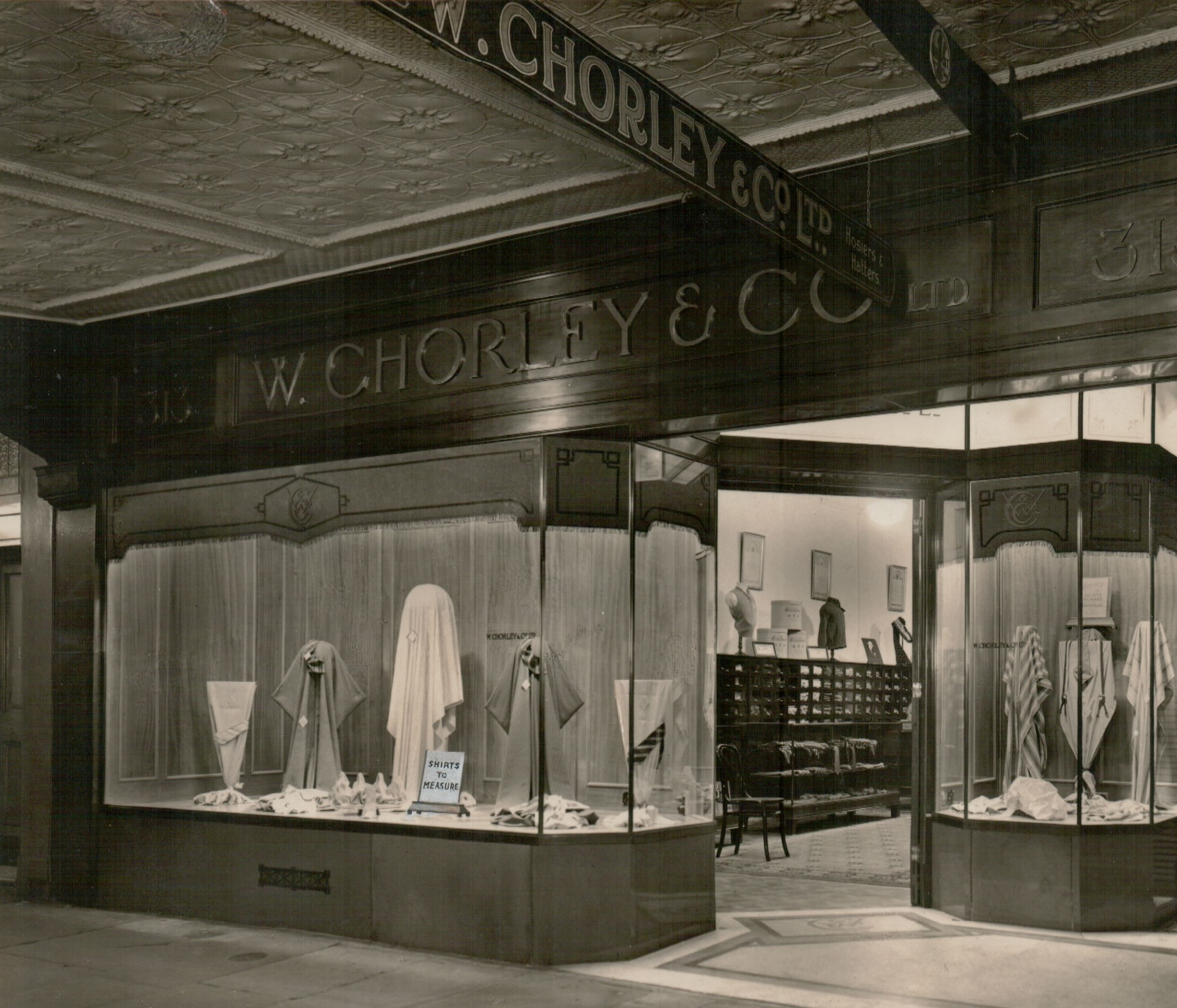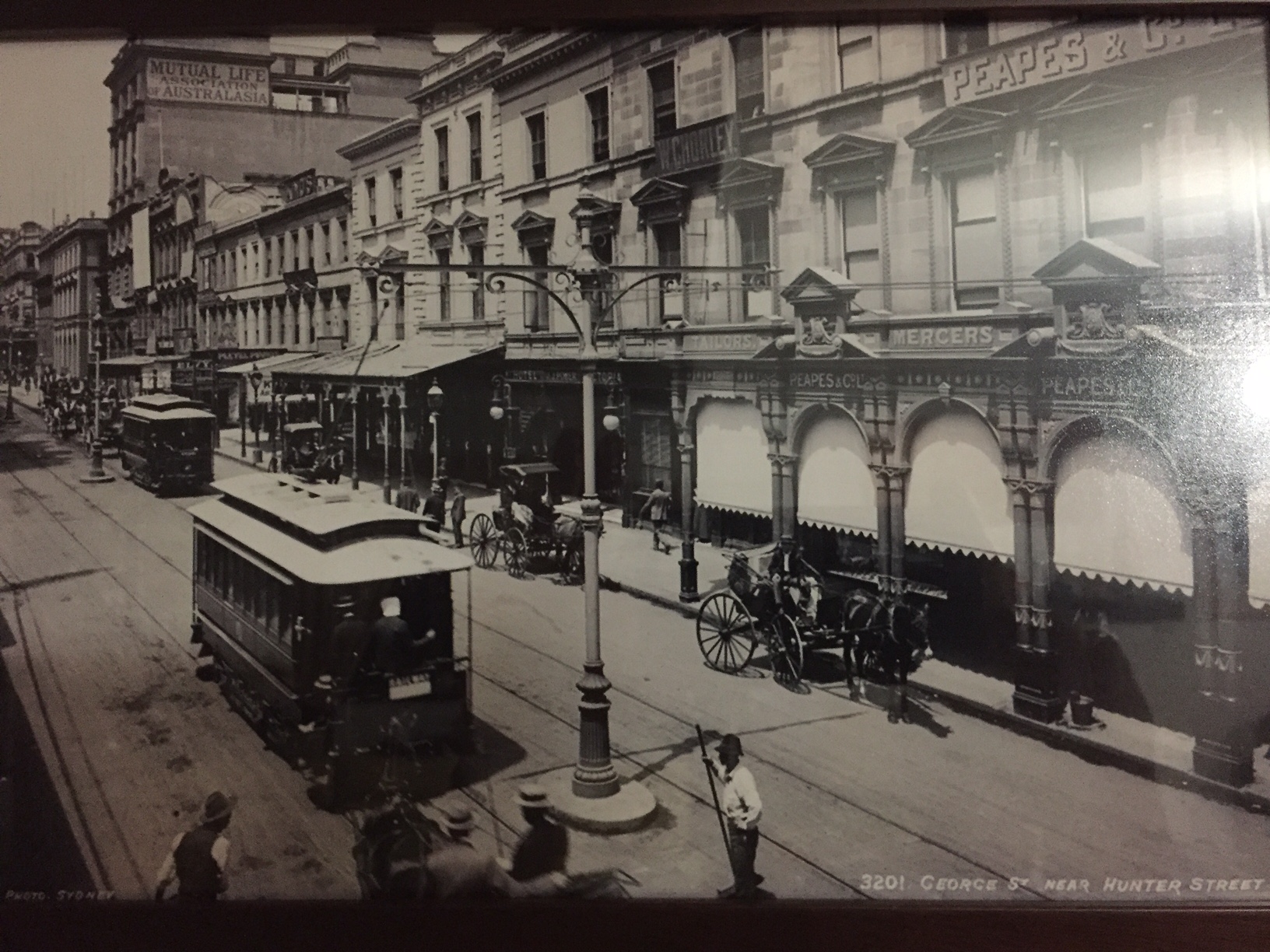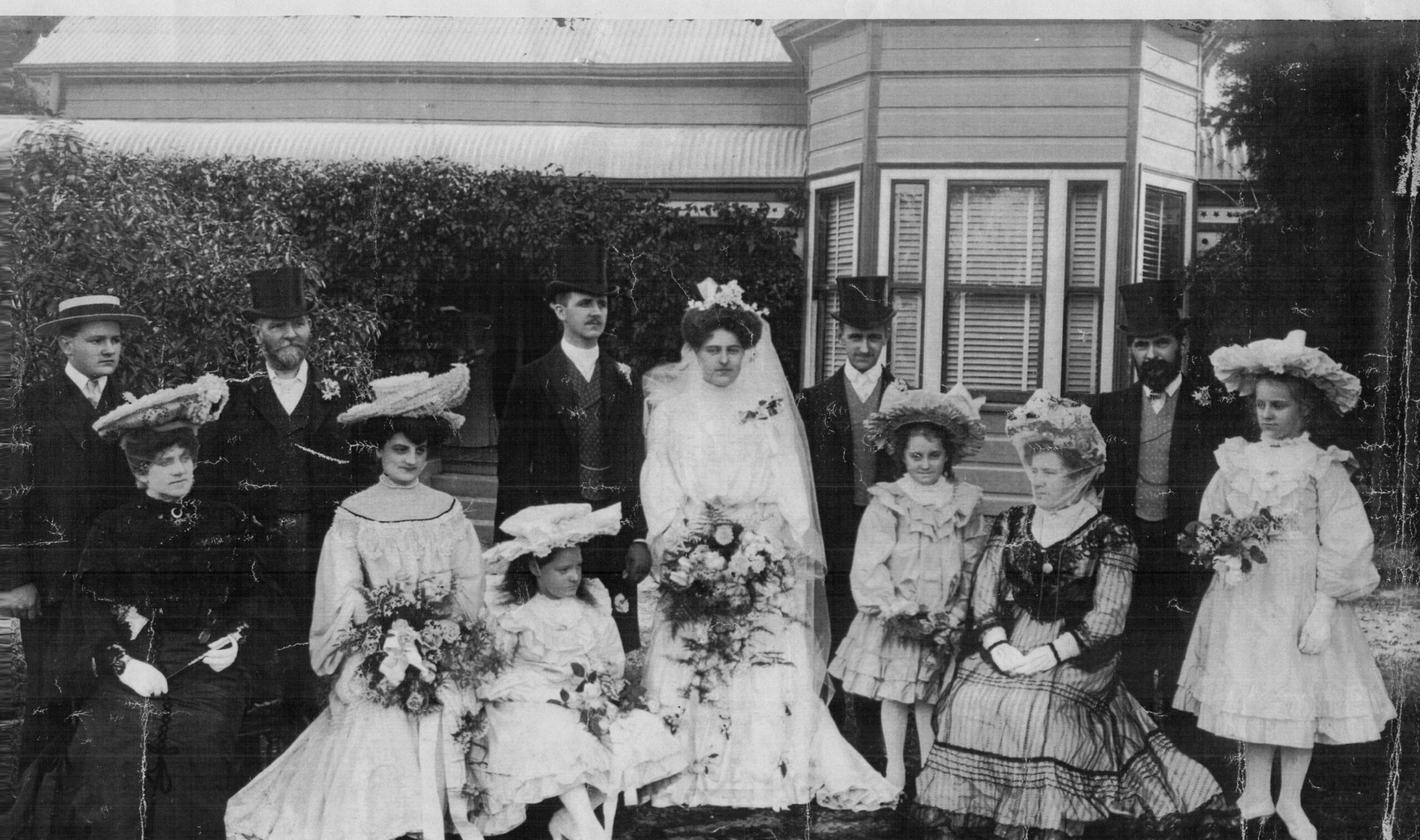William Chorley and Mt Pleasant Estate

William Chorley was born according to some records in Wiveliscombe and in others at Brompton Ralph, each in Somerset, on 21 March 1860 to James and Sarah Chorley. Each of his parent’s occupation was listed as agricultural labourer. By the time of the 1881 Census he was living with John Ayliffe and family at 20 Fairview Place Cheltenham, Gloucestshire. As Ayliffe was a tailor aged 73 years and Chorley a tailor’s cutter it can be assumed that Chorley was learning his trade from Ayliffe.
Later in 1881 Chorley married Lily Virginia Alder, in the Baptist Chapel, King Stanley, Gloucestershire. She was born in 1862 in Devon. When they married he was 21 and she 19 years. After marriage they lived in Magenta Place Cheltenham [1]. Their first child, Edith, was born in 1882, and the following year they emigrated to Sydney aboard the British Yeoman.
Chorley delighted to tell his children in later life that he had arrived in Australia with five pounds in his pocket, and this appears to have been correct recognizing that both sets of parents were working class and William and Lily were both learning their trade. Notwithstanding a lack of capital he bought the tailoring business which employed him once he was in Sydney and only a few months after his arrival. The firm ‘Chorley and Co. Tailor and Robe Maker’ in George Street, Sydney, soon had Vice-Regal patronage and when it closed after nearly one hundred years of business in 1980, it boasted it had tailored by appointment to every New South Wales Governor since 1883 and every Governor-General since Federation.


The firm specialised in formal court dress and service uniforms. It made the Privy Council uniform worn by Sir Isaac Isaacs (also the first Australian born Governor General) in about 1930 which is now part of the collection of the National Library of Australia. Other famous customers included the authors Robert Louis Stephenson and AB ‘Banjo’ Paterson. [2] One of the tailors for his firm, Peter Fallon (1881-1956) went on to become Secretary Federated Clothing and Allied Trades Union and a Member of the Legislative Council 1952-1956) [3].
During the 1890s depression Chorley, along with other leading retailers publicly took a stand on industrial practices and declared that they would not engage in ‘sweating’ which was a practice of underpaying staff and working them excessive hours – which they undertook to retain at least some paid employment [4].
As well as being a skilled tailor, William Chorley had a keen business sense, speculating successfully in large tracts of land in Beecroft after 1887. He moved his family from Strathfield to Beecroft about 1889 for the sake of Lily’s health and they lived at first in a small cottage in Beecroft Road. In 1889 William purchased three lots of half an acre each near Cheltenham station, and a large area of fourteen and a half acres extending from The Crescent to Beecroft Road, north of Kent Road (later Cheltenham Road). He paid £514 for this latter Crown Land. It was here, well back from The Crescent and facing the railway line, he built his home, ‘Mount Pleasant’ [5].
In 1890 William purchased a small town lot of a quarter acre on the western corner of Welham Street and Beecroft Road, on which he built a large bungalow for leasing. In 1891 three lots on Railway Crescent north of Hannah Street were purchased, on one of which the local bakery was later to be built. He also purchased three portions in Malton Road and Copeland Road East and seven acres of rough bushland on the southern side of Boundary Road. In 1893 the purchase of four and a half acres on The Crescent extended his home estate. His subdivision of 1910 provided for The Boulevard being built down the centre of this estate – allowing for further subdivision [6].
Beecroft residents were excited when the two bridges over the railway line at Copeland Road and Malton Road were opened in 1894, and William Chorley, amongst others, bought land across the line: three grants of four and a quarter acres on the north-eastern side of Sutherland Road (1894) and a large block of six portions, making thirty-one acres, between Malton, Kent, Sutherland and Kethel Roads (1895). He paid only £139 for this hilly bushland. A further purchase extended this estate south of Kent Road [7].
In 1898 Chorley added another four acres to the north of his ‘Mount Pleasant’ estate and in 1899 four acres on its southern boundary. Also in 1899, a five acre block of bushland in Malton Road, east of Clarke Road, was purchased [8].
In ten years, Chorley had purchased over 80 acres of Beecroft land, much of it to be subdivided by him from 1909 onwards. He retained a large area for his home, and his purchase of bushland, with creeks, valleys and waterfalls were for his and his family’s enjoyment. He frequently took them for picnics in the bush at the end of Kent (later Cheltenham) Kethel and Day Roads, carrying with them a hot meal packed in a clothes basket. Their favourite picnic spots he named after his daughters – Beatrice Falls, May’s Hill, Alice’s Glen. The family also holidayed at their holiday house in Palm Beach.
It was William Chorley’s proposal to the Railway Commissioners that brought about the building of a platform between Epping and Beecroft, thus saving himself a sulky trip twice a day to Epping. He paid the Commissioners £100 of the £260 cost of the overhead bridge, and George Rattray (who owned a large property between Beecroft Road and The Crescent which William Harris was to purchase a few years later and named ‘Edensor’) also paid £100. Chorley chose the site, close to his home, and gave the platform the name ‘Cheltenham’, remembering the fine Georgian spa town in Gloucestershire which he had left to come to Australia. With nostalgia, and perhaps with a vision of another Cheltenham in Sydney, he named the roads in his subdivision ‘The Promenade’ after the main wide, tree-lined street of the English town and ‘The Boulevard’. The road running along the western side of the railway line had been known as Carlingford Road and it became Chorley Crescent and later The Crescent. Kent Road running from the overhead bridge at the new platform to William Kent’s Epping grant became Cheltenham Road. Chorley sought to maintain a high standard of residential development in his sub-divided land after 1910 by stipulating precise requirements in his covenants. There was to be one house per lot, no commerce or industry, and houses of a good character [9].
It was generally thought that homes would soon be built on the eastern side of the line close to the new station, but it was not until 1925 that the first house was constructed there, being built by Chorley for his daughter Alice.
Lily and William had seven daughters and two sons, born between 1882 and 1903. Their sons Henry and William (Bill) attended Sydney Grammar School before working with their father in the tailoring firm. The elder girls went to Beecroft Public School and Sydney Girls’ High School, and the youngest, Ethel, to Miss Long’s Beecroft College before travelling to the recently built Presbyterian Ladies’ College at Pymble. All the daughters married except (Lily) May, who lived at home with her parents. William Chorley was a good provider for his children, and built homes nearby for five of them, in The Crescent opposite the station in 1904 and 1909, and in Cheltenham Road east of the station after 1924 [10].
The house ‘Mount Pleasant’ on high land with a long view south was a two storey timber construction with an iron roof and verandas on three sides. The main bedroom and a library were on the ground floor and four more bedrooms on the upper floor. In 1920 alterations were made, with the front and side verandas replaced with a larger veranda and a sleep-out above. The lower walls of the extension were of sandstone. A stone wall was built around the property, with an iron top on the Cheltenham Road and The Crescent walls, and a full stone wall along The Promenade boundary for privacy. The stone came from Chorley’s quarry across the line close to Sutherland and Cobran Roads.
A large garden, including a conservatory, was established when the house was built and an orchard planted with many kinds of fruit, as well as Macadamia nuts and several varieties of grapes. The first consignment of fruit sent from the new Cheltenham station to the Sydney markets was a dozen cases of apricots and plums from the ‘Mount Pleasant’ orchard (1898). There were cows and horses in the paddocks and stables and sheds for the sulkies, buggies and four-wheelers. Maize and oats were grown for fodder. The gardener lived in quarters above a workshop and two extra gardeners were often employed. A tennis court was laid out early, and in 1920, when William retired (and notwithstanding the proximity of the Cheltenham Recreation Club), a bowling green and croquet lawn were laid out between the house and The Promenade [11].
For all of his life William loved large dogs, and one special favourite was Nero, a handsome Newfoundland. A small lightweight cart and harness was made for Nero to pull the youngest child, Ethel, around the garden. In keeping with the theme of the English Cheltenham, William planted Scotch pines along both sides of the railway line near his home, and when in 1900 one hundred ornamental trees from the Forestry Department were requested by the Progress Association, he undertook to oversee their planting in Cheltenham streets [12].
Whatever William Chorley took from his suburb in the way of financial gain, he gave back in service to its community. He was an early member of the Beecroft Progress Association and at various times was its President and Treasurer. He was Chairman of the School of Arts building committee and President of the committee when the building was opened in 1904. It was due to Chorley’s friendship with the Governor, Sir Harry Rawson, that His Excellency was invited to open the building. The local newspaper reported:
‘Mr. W. Chorley, JP … who has taken such an active part in the movement for the establishment of a modern School of Arts in Beecroft is endeavouring to arrange for a body of Lancers to act as an escort for the Governor from the Railway Station. On the opening day he will entertain at his well-known picturesque residence at Cheltenham the Hon. B.B. O’Conor and Mrs. O’Conor and other notable visitors to the function.’
A further report told of Chorley’s intention to take O’Conor (the local member) for a drive around the Beecroft district on that day and point out ‘a long list of requirements’ and suggesting prompt attention to them [13].
When the local School Board was renewed in 1906, William Chorley was one of its members, and he continued his interest in it for many years. School picnics were held in his grounds (in the paddock between his home and Beecroft Road), he presented the annual prizes at times and in 1912 he unfurled the flags in an exchange of Union Jacks between Beecroft School and Cheltenham School in England. The local cricket teams played in Chorley’s paddock [14].
In 1908 the young Musical and Dramatic Society appointed William Chorley its President. Henry Chorley was on the committee and his sisters offered their musical talents to this group and at other charitable performances. In 1913 William was President of the local Liberal League and his wife one of the committee [15].
The Chorleys, who had been Baptists in England, at first attended St. John’s Church of England in Beecroft, William being appointed an auditor in 1891 and Lily Chorley its first organist. In 1894 when the Wesleyans were planning to build a church, William was on the building committee and Lily Chorley was one of the lady collectors who canvassed the district for donations. When the Presbyterian church began in Beecroft the Chorleys joined it, and Lily Chorley laid the foundation stone of the new building in 1908. She also donated its first organ which at times she played. The Chorley sons, Henry and William, were married there in 1909 and 1912 respectively [16].

Later the Chorleys attended the Epping Congregational Church until 1927 when William gave a block of his land on the corner of Beecroft Road and The Promenade for the erection of a Congregational Church in Cheltenham. His wife was to lay the foundation stone, but as she was too ill on the day to do so, their eldestdaughter, Mrs Edith Graham, performed the ceremony.
Lily Chorley died the following year.
William lived at home with his unmarried daughter May until his death in 1935 at the age of 76 years. He left an estate of £63,000 to his children. The house was demolished, the land subdivided and sold, and only the stone walls and a few pine trees on the verge remain to mark the site of the extensive ‘Mount Pleasant’ estate [17].
1. Sporting Life 21 January 1880.
- Undated newspaper cutting, Chorley family. The article was written for the move of the business from George Street to
- . Wynyard in 1950. Link Governor General Sir Isaac Isaac’s Uniform. The family also owned Kitchener & Co of 44 Hunter Street Sydney who were also tailors and mercers – Link Button History accessed 10 January 2020. From 1883-1884 the firm was at 80A Pitt Street then until 1896, 72 Hunter Street. Also Gloucester Citizen 5 November 1861; Gloucestershire Echo 19 October 1950.
3. https://www.parliament.nsw.gov.au/members/pages/member-details.aspx?pk=1366 accessed 10 January 2020
4. Sydney Morning Herald 21 December 1891 page 8
5. Land Titles Office, 1091/41; 1003/194-5. The ‘Mount Pleasant’ house stood on the site of the present nos. 46-48 The Crescent Also refer Street Names ‘The Cresent Cheltenham’ on this site.
6. LTO, 863/24; Cumberland Argus, 15 April 1899; LTO, 1023/52, 985/97; 1139/196-7; 1129/207.
7. LTO, 1231/27; 1231/208.
8. LTO, 1256/74; 1282/219; 1239/121.
9. Cumberland Argus, 17 April 1897, 27 August and 15 October 1898; LTO, 1129/207.
10.The two Chorley houses opposite the station are the present no. 52 (built for Harry) and no. 54 (built for Bill and later Edith and her husband George Graham), in Cheltenham Road East are no. 19 (built for Alice and her husband Albert Tulloch), no. 7 (for Bill), and no. 3 for Ada and her husband Joseph Allison.)
11. Cumberland Argus, 26 November 1898; Yewen’s Directory of the Landholders of NSW, Ryde District, 1900. The family also had a week ender at Palm Beach: Sydney Morning Herald 24 April 1935 page 10
12. Cumberland Argus, 14 July 1900.
13. Cumberland Argus, 14 March 1903, 6 February 1904, 12 November 1904, 3 December 1904.
14. Cumberland Argus, 24 November 1906.
15. Cumberland Argus, 31 October 1908, 8 November 1913, 14 August 1915, 18 August 1917, 3 May 1918.
16. McCaskill, p. 10; Wesleyan Methodist Minutes, Ryde Circuit, Building Committee Minutes, 6 June 1894, Cumberland Argus, 26 September 1908.
17. Information from Mrs Ethel Rayner of Eastwood and Bert Tulloch of Turramurra.
